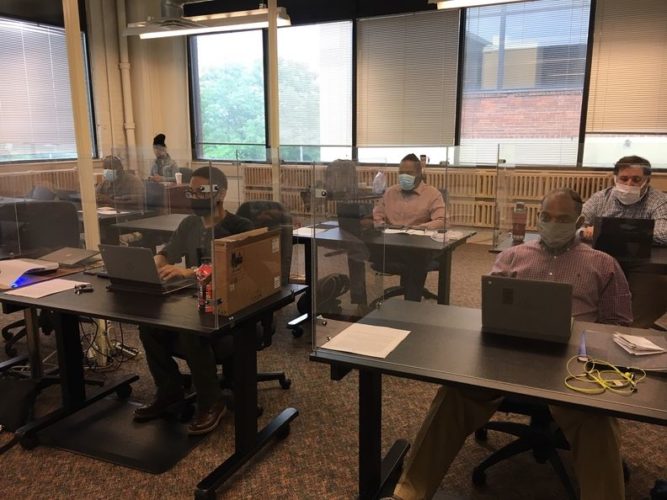Path to digital literacy: Bridging skills gap is critical to workforce success
 Article written by Rachel Abbey McCafferty
Article written by Rachel Abbey McCafferty
Published September 18, 2021 04:00 AM
Read the original article here on Crain's Cleveland Business.
Today, technology is ever-more present at the workplace, whatever that workplace is. There's increased automation; there are remote conference calls. Digital skills and literacy are a must, particularly for higher-wage jobs.
"From an equity standpoint, it's absolutely essential that we're able to close this digital divide so that in the future of work, when these things are going to get more important, people are not continuing to be left behind," said Jill Rizika, president and CEO of Towards Employment.
The COVID-19 pandemic brought the digital divide — the inequities caused by a lack of at-home internet access and technology — to the forefront. The workforce-development sector was no exception. Educators and training providers had to adapt to remote classrooms and help students who lacked the necessary access get it. But the pandemic isn't the endpoint. As remote work and technology-enabled jobs become more prevalent, closing the digital divide becomes more important than ever.
The pandemic made Stark State College's educators realize how important it was to "meet the students where they're at," said vice president of advancement, human resources and partnerships Marisa Rohn. Community college students in particular range in age and experience and background, she said, and pivoting to online education highlighted those different skill levels and needs.
Stark State's counselors serve as the entry point for students, directing them to resources as needed, whether that's immediate funds for a laptop or information about free internet programs, Rohn said.
That type of individual assessment has been critical at Towards Employment in Cleveland, too. Towards Employment works with populations that may have struggled to connect with the workforce, like those with criminal records. Digital literacy had long been part of the nonprofit's curriculum, but the pandemic meant changing how resources, support and training were delivered.
Towards Employment provided everyone with a Chromebook — a support it hopes to continue in the future — and created a new position for client-focused technology support, Rizika said. It also began conducting a digital skills assessment and providing training before individuals started their programs. Participants needed to understand how to use the digital programs classes would be held through if they were going to succeed.
One of those programs was ACCESS to Manufacturing Careers, a re-entry program for formerly incarcerated individuals focused on preparing people for entry-level manufacturing jobs. The program, which has now been expanded to serve other populations like young adults, is part of the region's manufacturing sector partnership, and Towards Employment was one of the training partners.
The partnership was about to launch the ACCESS program when Ohio's first stay-at-home order was announced, said Adam Snyder, managing director of sector partnership at MAGNET in Cleveland. The group had to press pause and turn the program's content mostly digital, moving to a hybrid model of education. The digital divide "added an element of complexity to the training," Snyder said.
Before the class began last spring, Towards Employment worked to ensure students had the digital skills they needed for online learning, offering assistance when necessary, Snyder said. The partners received donations of Chromebooks and hotspots for students. And MAGNET built a classroom designed for COVID-19 safety for those lessons with hands-on components.
The manufacturing sector partnership has only been active for about two years, which means the majority of its work has had to take place in a pandemic environment. The group was aware of the digital divide before COVID-19, Snyder said, and knew that it could create barriers for the people they were trying to recruit for manufacturing careers, whether in terms of the application process or the skills they needed for the plant floor.
But the pandemic highlighted the depth of the digital divide for many in the workforce development space.
Snyder said he doesn't think the ACCESS program will ever go to a fully in-person model now. The hybrid approach offers flexibility that helps participants overcome transportation or child-care challenges. And it also gives students experience using computers, an increasingly important skill in today's jobs.
The digital divide will continue to be an issue going forward. Snyder said he thinks there's a role for educators to play in helping individuals build new competencies, like those that want to transition careers.
At Cuyahoga Community College, leaders are meeting with the business community to determine what skills will be most needed in a "post-pandemic environment," said William H. Gary Sr., executive vice president for workforce, community and economic development. Tri-C knew the digital divide was an issue affecting the community and contributing to the skills gap prior to the pandemic, Gary said, and digital literacy was part of many of its workforce development programs.
But now, Tri-C is creating courses focused specifically on IT skills development, and making sure curriculum across industries like nursing or logistics includes digital literacy to prepare students for the digital skills needed in their particular field. It's a more "comprehensive approach," Gary said.
"I think COVID has awakened a lot of us to be more proactive, to look at jobs and the workforce in a more holistic fashion," Gary said.
